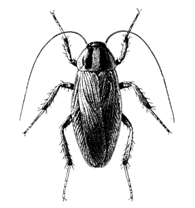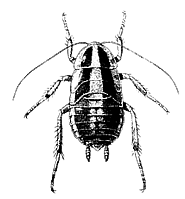german cockroach

Description
Roaches in general are held suspect as disease carriers. Laboratory tests have shown such diseases as Salmonella and infectious hepatitis can be carried by these pests.
"When feces infected with Salmonella oranienburg were spread on human food and on glass, the bacteria survived for the following periods: on corn flakes - 3.5 years; on crackers - over 4.25 years." ... "
New York State Department of Health.


The adult German cockroach is pictured on the left with the Nymph on the right. However, the typical homeowner may see more nymphs than adults.
The female German cockroach, during her lifetime, produces four to eight egg capsules each of which contains 30 to 40 eggs. The female carries the egg capsule partially within her abdomen until just before the nymphs are ready to emerge. Approximately one to two days before hatching she drops the egg capsule in a protected area. Nymphs will molt six to seven times before becoming adults -- this requires about 103 days -- thus allowing three to four generations per year. Adults live approximately 100 to 200 days.
Range and Habits
German cockroaches are the most common household insect within the United States. This pest typically infests kitchens and bathrooms but will live anywhere inside heated structures in which there is food, water, and harborage. They rarely are found outdoors and then only during warm weather. German cockroaches gain entry into structures in grocery bags, cardboard boxes, drink cartons, infested equipment such as used refrigerators, toasters, microwaves, etc. Cockroaches feed on all types of human food.
Damage and Control
Because German cockroaches typically are brought into structures, potentially infested products should be closely inspected. Many types of cardboard and plastic sticky traps are available to help pinpoint sources of cockroach infestation and to monitor areas about which occupants have complained but infestations cannot be visually detected. Sticky traps are not intended for control but are used to guide and evaluate control efforts as part of the inspection process. Visual inspections can be conducted using a flashlight and aerosol pyrethrin to flush cockroaches from their harborages. An effective cockroach management program depends on good sanitation to eliminate the food, water, and harborage they need for survival. Cleanup to reduce cockroaches in the home and office environment must focus mainly on the food residue in and around coffee machines, microwave ovens, stoves, refrigerators, trash cans, furniture, and areas where exposed food is stored. It is critical to reduce clutter as cockroaches like to hide in stacked boxes, cartons, and stored paper and cardboard materials, especially in dark, damp locations, near food. Vacuum cleaning can be used to physically remove exposed cockroaches.
Permanent reduction of cockroach populations can be achieved by caulking to eliminate harborage. The most important cracks to eliminate include those at which sinks and fixtures are mounted to the wall and floor, around all types of plumbing, baseboard molding and corner guards where shelves and cabinets meet walls and door frames, and cracks on or near food preparation surfaces. Cockroach access routes between apartments and from wall voids, and around plumbing and electrical fixtures should be sealed with caulk or grout. Basement floor drains should be protected with screens or basket inserts.
Member of International Association of Mold Management
A current test result can give you the prospect of better health condition in your home, and peace of mind knowing what does or does not breed within the walls of your home.
- 48 hour results by a Ph.D.
- Remediation
- Storage
- Sanitation